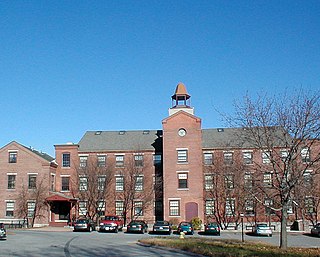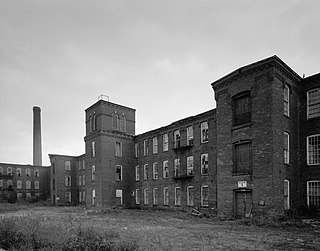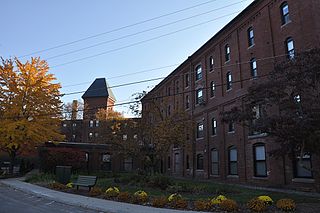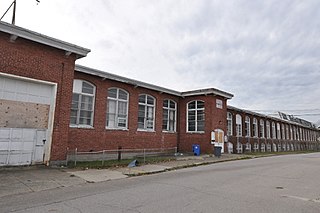
John Willard Capron was an American military officer in the infantry, state legislator, and textile manufacturer. Famous for being a military uniforms manufacturer, he became Colonel in the army and Chairman of the Board of Selectmen.

The Bemis Mill is a historic former industrial building at 1-3 Bridge Street, in the village of Nonantum, in Newton, Massachusetts. It is now a general office building called the Meredith Building. The building is significant historically as a surviving early industrial building in the city, and for the remnants of unique power distribution and water control facilities that survive. On September 4, 1986, it was added to the National Register of Historic Places.

The Hayward Mill is a historic mill complex at the junction of North and Cook Streets, on the Mumford River in Douglas, Massachusetts. The site, with an industrial history dating to the 18th century, is populated by a series of connected buildings dating to 1880 or later. The mill was the first financial successful textile operation in Douglas, and was operated until the 1960s. The mill complex was listed on the National Register of Historic Places in 1991. It has been converted to residential use.

The Duck Mill is an historic mill complex at 60 Duck Mill Road in Fitchburg, Massachusetts. With a construction history dating to the 1840s, it is one of the city's oldest surviving textile mills, now readapted to residential use. The complex, long used to produce cotton duck, was listed on the National Register of Historic Places in 1985.

The Old Colony Iron Works-Nemasket Mills Complex is a historic industrial site located on Old Colony Avenue in the East Taunton section of Taunton, Massachusetts, United States, adjacent to the Taunton River at the Raynham town line. The site was first occupied by the Old Colony Iron Company, which had originally been established in the 1820s as Horatio Leonard & Company. The western part of the complex was sold to Nemasket Mills in 1889. The eastern part was acquired by the Standard Oil Cloth Company. The site was added to the National Register of Historic Places in 1984.

The Whittenton Mills Complex is a historic textile mill site located on Whittenton Street in Taunton, Massachusetts, on the banks of the Mill River. The site has been used for industrial purposes since 1670, when James Leonard built an iron forge on the west bank of the river. The first textile mill was built in 1805 and expanded throughout the 19th century. The complex was added to the National Register of Historic Places in 1984, and now contains various small businesses.

The D. E. Makepeace Company is a historic industrial building at 46 Pine Street in Attleboro, Massachusetts. Built in 1899-1900, it is one of the city's best examples of a jewelry factory building of the period. The Makepeace Company was a major contributor to the city's reputation at the turn of the 20th century as America's jewelry capital. The building, now converted to residences, was listed on the National Register of Historic Places in 1985.

The Johnson Manufacturing Company was a historic mill complex at 65 Brown Street in North Adams, Massachusetts. Developed beginning in 1872 and enlarged through the early 20th century, it was at the time of its 1985 listing on the National Register of Historic Places a well-preserved example of late 19th century industrial architecture, used for the production of textiles for many years. The complex was demolished in 2007.

The Renfrew Mill No. 2 was a historic mill complex at 217 Columbia Street in Adams, Massachusetts. Most of its buildings were built between 1867 and 1878, and were brick buildings with Italianate styling. They were built by the Renfrew Manufacturing Company, a textile manufacturer, to replace an earlier complex further down Columbia Street that had been demolished. The property was acquired by the Arnold Print Works in 1928. The mill was the town's largest employer for much of the second half of the 19th century.

Windsor Print Works is a historic textile mill at 121 Union Street in North Adams, Massachusetts. Founded in 1829, with buildings dating to 1872, it was one of the first textile mills in western Massachusetts, and the first place in the United States to create printed cotton fabric. It was listed on the National Register of Historic Places in 1973. The property now houses a variety of arts-related and light manufacturing businesses.

The Wamesit Canal-Whipple Mill Industrial Complex is a historic mill and canal at 576 Lawrence Street in Lowell, Massachusetts. This industrial area of Lowell, located on the Concord River, underwent a major expansion from a more modest millworks in the mid-19th century by Oliver Whipple, a manufacturer of gunpowder.

The Saco–Pettee Machine Shops is a historic factory complex at 156 Oak Street in the Newton Upper Falls area of Newton, Massachusetts. Although the area has an industrial history dating to the early 19th century, the oldest buildings in this complex, consisting of about thirteen brick buildings, were built in 1892. The property, a major economic force in the development of Newton Upper Falls, was listed on the National Register of Historic Places in 1986. It was home to Clark's N.A., the North American home base to Clark's Shoes, makers of fine footwear, until they relocated to Waltham Ma. in October 2016.

The Jaffrey Mills is a historic mill complex at 41 Main Street, in the central business district of Jaffrey, New Hampshire. It consists of a connected series of primarily brick buildings flanking the Contoocook River just north of Main Street. Its oldest buildings, the original mill and office building, are on the west side of the river. They were built in 1868, and feature mansard roofs and banded dentil brick cornices. The mill building has a tower that originally sported a cupola, but this was removed early in the 20th century. In 1872 the building on the east side was built, and the two sides joined by timber-frame bridges were added in 1897, at the same time the east building was extended northward. Later additions to the north of the east building include a storage area and a loading dock. The mill complex, the only 19th-century industrial complex of its type to be built in Jaffrey, was listed on the National Register of Historic Places in 1982. It has been converted into residences.

The Sanford Mills Historic District encompasses a large industrial complex in the center of Sanford, Maine, United States. From 1867 to 1955, the property was the site of a major textile manufacturing operation that was a major local employer. The site, flanking the Mousam River just north of Sanford's central business district, was listed on the National Register of Historic Places in 2009.

The Nashua Gummed and Coated Paper Company Historic District encompasses a collection of former industrial buildings on the north side of the Nashua River in Nashua, New Hampshire. Located on Franklin and Front Streets west of Main Street, the complex was developed by the Nashua Gummed and Coated Paper Company, later the Nashua Corporation, beginning in the late 19th century. It was a major manufacturing and employment center for the city until mid-1990s, when the company's business declined. One of its former storehouses was converted to residences in the 2000s, and the main complex is, in 2015-16, undergoing the same process. The complex of surviving buildings was listed on the National Register of Historic Places in 2015.

The Naushon Company Plant is a historic textile mill complex at 32 Meeting Street in Cumberland, Rhode Island. First built in 1902-04 and enlarged over time, it illustrates the adaption of the site to differing uses between then and the 1950s, when its use for textile manufacture ended. The complex was listed on the National Register of Historic Places in 1978.

The Broad Brook Company was a manufacturer of textiles in East Windsor, Connecticut, which operated from the 1830s until 1954. The company plant, located on Broad Brook at Main Street and Scott Road in the town's Broad Brook village, was listed on the National Register of Historic Places in 1985. Partially destroyed by fire, with surviving buildings converted into residential condominiums in the 1980s, the complex has been shuttered due to the discovery of toxic soil conditions on the property.

The Briggs Carriage Company is a historic industrial complex at 14 and 20 Cedar Street in Amesbury, Massachusetts. Built before 1890, these two buildings are a surviving reminder of the city's late 19th century prominence as a major carriage manufacturing center. They were listed on the National Register of Historic Places in 2007.

The Dodgeville Mill is a historic mill complex at 453 South Main Street in Attleboro, Massachusetts. With industrial history dating to 1809, it is one of the city's oldest industrial sites. The complex now consists of an accretion of frame and brick buildings, constructed over the 19th and early 20th centuries. Textile production, which included manufacture of Fruit of the Loom branded products, ended at the site in 1970s.

The American Optical Company Historic District encompasses a historic industrial complex on the Quinebaug River in Southbridge, Massachusetts. Located on roughly 80 acres (32 ha) east of downtown Southbridge, the complex was developed between the 1880s and 1950s by the American Optical Company (AO), one of the largest manufacturers of eyewear at the turn of the 20th century. The district was listed on the National Register of Historic Places in 2023.






















